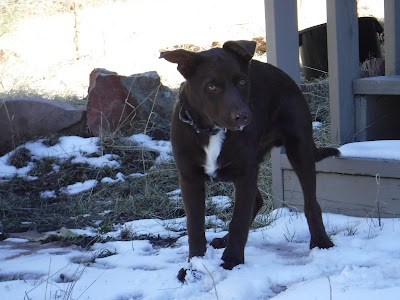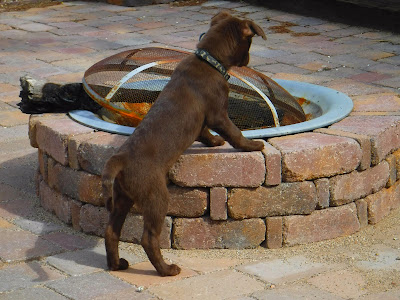Being working dogs, McNabs like high-octane toys that keep them moving. They aren't content just cuddling up with a stuffed toy or carrying things around like my gentle Labs did. They want to be running, leaping, and chasing. The toys listed below are not in any particular order.
Boomer Ball / Jolly Ball Push-and-Play Ball
 |
| Ethan with his much-loved Jolly Pets Push-n-Play Ball |
The first Boomer Ball I ever bought was many years ago as a horse toy. At the time I had Dalmatians. One of my Dalmatians went crazy for that original Boomer Ball. To my surprise, she became obsessed with pushing it at speed across the horse pasture, then corralling it with her muzzle and pushing it back, yipping with excitement the entire time. I still have that original Boomer Ball, which is now over 25 years old. They may not last forever, but then again ... they might.
Once he'd become reasonably mature (over five months old) I introduced Ethan to the Boomer Ball and to my delight, he loved it. I followed up by buying him the Jolly Ball brand equivalent - a 14" Jolly Pets Push-n-Play Ball. Ethan is every bit as obsessed with it as my Dalmatian was. He begins yipping happily as soon as he attacks it, then "herds" it across the property, cuts it off and herds it back. One feature of this type of play is you can use it to teach useful commands that translate to livestock work or other activities.
These balls are hard plastic and can take a beating. They're difficult, if not impossible, for the dogs to chew up as they can't be compressed like vinyl or rubber balls. Take your time introducing the dog to them; show them how to play with it by pushing it back and forth with your own feet like a soccer ball. McNabs learn easily by watching and it won't take long for them to develop confidence with the ball, but at first, until they learn how to maneuver it, they may be intimidated.
You can buy a Jolly Pets Push-n-Play Ball on Amazon here: Push-n-Play Ball(affiliate link). These are terrific for any herding-type dog. (And some horses!) This type of ball can also be filled with water. If you fill them 1/3 or 1/2 way, they'll roll with unpredictable results - which some dogs just love.
 |
| Ethan shows how to "herd" the ball. |
 |
| Three McNabs, one ball, and a human activity director. |
Jolly Ball
Again, my first introduction to the Jolly Ball was via my horses, long ago. I bought a large one for a particularly active colt, who loved to throw the ball - literally - over his arena fence and onto oncoming cars. Ethan, though, is the first of my dogs to love playing with the Jolly Ball, a large, durable (but not hard), rubber ball with a handle. You can buy them through Amazon here: Jolly Ball (affiliate link) in various sizes and colors. The original Jolly Ball is prone to being chewed. Ethan has gnawed holes near and on the handle on both of his, and I no longer let him bring it in the house. When he's outside, he happily carries it around the property and doesn't destroy it. Because these types of ball don't rely on holding air to hold their shape, they're good in our desert terrain (think: cactus) and don't deflate.
Laser Toy
Yep. McNabs go crazy over the laser toys. From the humble mouse-shaped laser pointer to the grand poobah of all laser toys - the PetSafe Dart - they go bonkers chasing that light around. All three of our McNabs (and all three cats) are in for a good time when the laser game starts, and all six animals play at once. Mass hysteria! If you haven't seen the PetSafe Dart Automatic Rotating laser toy, it's a battery-operated laser projector that rotates, pauses, and otherwise engages the dog (or cat) without your intervention. Ours has stood up to lots of abuse and I've had to reassemble it many times, but it's well worth it. You can buy one through Amazon here: Automated Laser Pet Toy (affiliate link).
Small or Long Plush Toy
Although all three of our McNabs like stuffed toys, their favorites are small, cat-size toys (toys the size of cat toys, not toys the size of cats, that is). Earl, our senior McNab, just loves carrying around plush toys that fit in his mouth. Ethan's favorite stuffed toys are actual plush cat balls (no, not those - the tiny stuffed balls made for cats). Recognize that smaller toys can be a choking hazard, and supervise their play properly. Do McNabs shred plush toys? Sometimes. Ethan does; Earl doesn't. Please use caution with any toys that have battery-operated noisemakers. Those little disk-type batteries can kill animals or humans that ingest them.
When Ethan plays with his tiny plush ball toys, he does so much as the cats do - pouncing on them, tossing them in the air, and retrieving them when I throw them. For some reason he doesn't shred the balls as quickly as he does the squeaky toys; without the noisemaker, there may not be as much incentive to find out what's inside.
Of the larger plush toys, the crinkly ones are Ethan's favorite. He loves to shake them violently. This is his choice: Stuffing-free plush toy (affiliate link).
Earl's choice is the Migrator Duck plush toy: Earl's favorite Migrator Toys (affiliate link).
Cheap Rubber Balls: Earl's favorite toys include plain ol' cheap vinyl balls, the kind you pick up by the half-dozen at PetsMart. He's picky, though: he doesn't like tennis balls, hard-rubber balls, or more expensive types. He likes the kind that don't pick up dirt, squish properly in his mouth, and make a little bit of a squeak when he squeezes them. Here's an affiliate link for Earl's choice: Inexpensive squeaky balls. Earl often carries these around while he's chasing the cows. Also, the cows will eat them, because, cows.
Antlers: Although not technically a toy, I'm listing these here as they are by far the best "durable" variety of chew toy our McNabs like. Not all dogs enjoy them, but if your dogs do, they're a high-quality product that is, in my opinion, quite safe. They don't splinter, they last for a long time, and they do a fantastic job cleaning the teeth. There's no strong or offensive odor, either. I buy them by the pound; before you invest in that many, though, consider buying a single antler for your dog (here's an affiliate link: Single antler. If your dog doesn't take to it right away, you can dip it in peanut butter or even beef broth to get them started. Here's an affiliate link for the one-pound pack: Antlers galore
You can buy antlers in either solid chunks or cross-cut so the yummy inner core is exposed. Our dogs - including the Papillon - will chew these to the point they are completely hollowed out. Here's an affiliate link for the cross-cut variety: Split antler dog chew.
Feather Wands / Cat Teaser Toys: Perhaps I've corrupted my McNabs by raising them among cats. Our cats act like dogs and our dogs often act like cats. Our McNabs are wild about playing "the game" with feather teasers. Just like with the laser toys, they play alongside the cats when the teaser comes off the top of the refrigerator (where the thieving McNabs can't get to it). I buy the teaser toys monthly, as they don't last long. Ours like the retractable type the best, and even when the Papillon has snatched the feathers from the end, the McNabs still love bouncing around when we wave the featherless wand. Here's an affiliate link: McNab feather teaser.
I also bought the McNabs a special teaser toy just for dogs, and they love it - but it's quick and easy to just grab the ol' feather teaser. For more aggressive play and a very durable product, check out this affiliate link for the amazing Squishy Face dog teaser: Dog Teaser Wand. This is the brand I bought, and it's a fantastic way to give your McNab a workout. Also, what a great name ... "Squishy Face."
A Caution About Tug Toys: Earl and Molly both adore tug toys. However, I no longer encourage them to play tug of war, and I actively try to prevent it. Unlike some dogs, they never did get into actual serious fights, but they played tug so aggressively that Molly, in trying to get a better grip on the toy, injured Earl several times - on two occasions requiring trips to the veterinarian, and one of those trips involving sutures, drains, and costly bills. If you have one tugger in the house, go for it. If your dog is aggressive, though, tug toys aren't recommended. Use your discretion.
Copyright (c) 2018 by MJ Miller * All rights reserved * No part of this content may be reproduced without express permission of the author, including photos, but links to this page may be freely shared and are greatly appreciated * Thank you for linking, liking, sharing, emailing, Tweeting, and using carrier pigeon to help grow my readership * Most of all, thanks for stopping by!

















